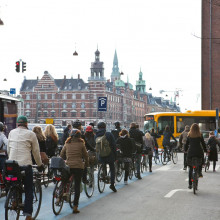In a project collaboration with Gehl, an urban design consultancy, Copenhagen Solutions Lab has mapped the patterns of flow in the area around the City Hall Square from September 2019 to September 2020.
The mapping was originally carried out with the aim of measuring patterns of flow before and after the opening of the new Metro City Ring in order to examine which effect the opening of the Metro City Ring would have on the patterns of flow at and around the City Hall Square. However, the original mapping was suddenly challenged by COVID-19 and the following lockdown of Denmark in the spring 2020, that from one day to another put especially the city center in Copenhagen on hold. The mapping has therefore ended up showing both the effect of the Metro City Ring and COVID-19 on patterns of flow at and around the City Hall Square. The results from the mapping will be used by the City of Copenhagen in the urban development and planning of the city.
The flow-project was one of the five projects that the Nordic Smart City Network worked together on in 2018-2020 with funding from Nordic Innovation and input from all cities. You can find the results and a video from the project here
In order to map the patterns of flow, the project has made use of data from online surveys (with more than 1500 respondents from the Copenhagen Citizens’ panel), Lived Experience data collected by Gehl (Sept. 2019, Feb. 2020, and Sept. 2020), flow data from The Copenhagen Metro, traffic data from JC Deacux and counting from Springboard’s sensors.
Selected results from the mapping
In general, the mapping shows a clear effect of the opening of the Metro City Ring and COVID-19 on the patterns of flow in the area around the City Hall Square
The effect of the opening of the Metro City Ring on flow
- After the opening of the Metro City Ring, a clear peak load with cyclists developed in the morning and afternoon, but in an overall perspective there are more pedestrians than cyclists at the City Hall Square.
- Since the opening of the Metro City Ring there has been an 120% increase in pedestrian activity at the City Hall Square and almost the same increase in people staying at the City Hall Square.
- Results from online surveys show that the citizens in Copenhagen feel that the City Hall Square has become more accessible after the opening of the Metro City Ring.
The effect of COVID-19 on flow
- During the lockdown of Denmark in the Spring of 2020, the movement activity decreased with more that 80% in the city center in Copenhagen.
- The week before the lockdown the sensors registered 589.808 people at the City Hall Square, while the week after the lockdown only 188.446 people were registered and a couple of weeks later only 64.590 people were registered during one week.
- The online surveys show that the citizens feel more insecure in using public transportation (bus, metro and train) after COVID-19. At the same time there has been an increase in cycling, walking and using the car as means of transport.
- The online survey has also observed new behavioral patterns during and after the COVID-19 lockdown. Before the lockdown 21% responded that they were likely to talk to people in the public space, while this number increased to 40% during the lockdown in the spring 2020 and increased further to 53,1% after the reopening (sept. 2020).
